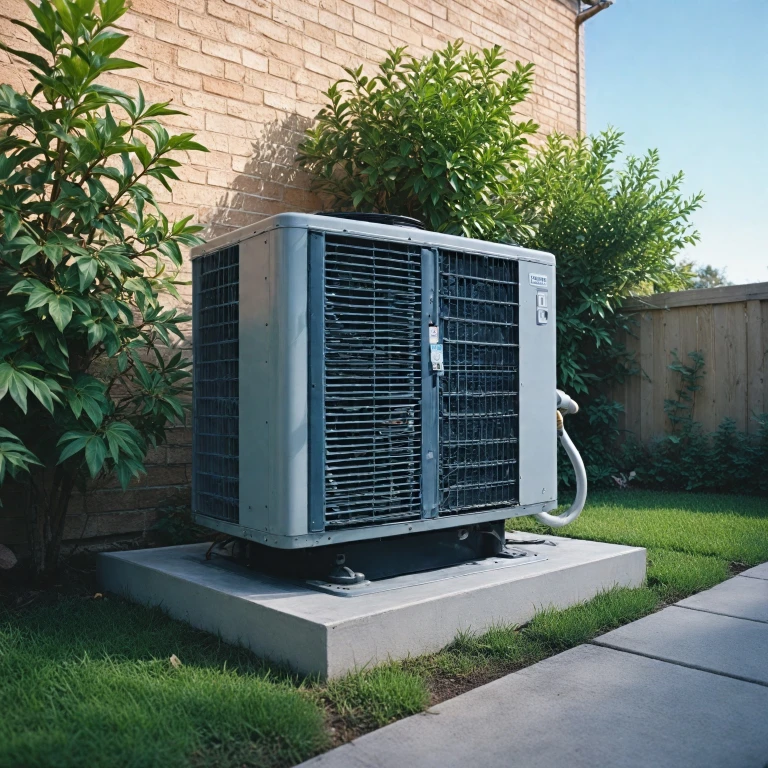The Role of the Compressor
Unveiling the Importance of the Outdoor Unit's Powerhouse
In the intricate dance of an air conditioning system, the compressor stands as the heart that ensures efficient cooling. Nestled within the outdoor unit, this crucial component works diligently to maintain the flow of refrigerant through the system. By compressing the refrigerant gas, it raises the refrigerant's temperature and pressure, preparing it for its journey through the condenser coils.
The compressor is a key player among various parts of an air conditioner, driving the transformation of warm air into the cool, refreshing breeze we crave during sweltering days. As the refrigerant passes through the compressor, its journey through the conditioning system begins—a journey toward the ultimate delivery of cool air.
The harmonious operation of the compressor and other air conditioner parts, like the evaporator coil and the fan, is essential to ensure optimal indoor air quality. Understanding the compressor's function helps demystify how the outdoor unit collaborates with the indoor unit to maintain a comfortable climate.
For those looking to make informed decisions about air conditioning solutions, exploring comprehensive resources like
choosing the right air conditioning unit for your grow tent can provide valuable insights. Whether dealing with a compact portable air conditioner or a more complex HVAC system, recognizing how each component works together is key to achieving effective cooling.
Condenser Coils and Their Function
Understanding Condenser Coils and Their Functions
Condensing coils are vital components in the system of an outdoor air conditioning unit. They work in tandem with other parts, like the compressor and fan, to siphon heat from your indoor environment and dissipate it outdoors.
These coils contain the refrigerant that has absorbed heat from the indoor air. As the refrigerant travels through the condenser coil, it gradually releases heat. The outdoor air conditioner’s fan and motor blow over these coils to enhance cooling efficiency, facilitating a faster transformation of the refrigerant from gas back to liquid form. This process helps in maintaining the cooling cycle efficiency, making sure the indoor environment stays comfortable.
To ensure seamless operation, the condenser must effectively transfer the acquired heat. Any obstruction in the coil’s fin or debris collected on it hampers this heat transfer, compromising the overall cooling performance. To dodge such inefficiencies, regular cleaning and maintenance of the outdoor unit are pivotal. This proactive upkeep not only extends the life of the air conditioner but also ensures consistent cooling.
The condenser coil’s design ensures the refrigerant’s efficient transition, supporting the whole air conditioning system in providing balanced and effective indoor climate control. For more on ensuring your unit’s optimal performance and longevity, this guide offers additional
maintenance insights. These tips help in safeguarding the entire HVAC system, from the condenser coils to the expansion valve, ultimately enhancing system durability and efficiency.
Fan and Motor Mechanism
Efficient Airflow Management for Optimal Cooling
In an outdoor air conditioning unit, the fan and motor mechanism play a pivotal role in ensuring efficient heat exchange. When the system is operational, the fan revolves to direct outdoor air over the condenser coils. This critical movement assists in dissipating the heat absorbed by the refrigerant when it transitioned from a gaseous to a liquid state within the condenser coil.
The fan and motor synergistically work to maintain a continuous flow of cool air over the condenser. By doing so, they enable the refrigerant to effectively release captured heat and maintain a cooled state as it cycles back towards the indoor unit. The fan's speed and efficiency are paramount for the overall performance of the HVAC system, directly influencing how well the air conditioner can cool the indoor air.
Moreover, a malfunctioning fan can lead to inefficient air conditioning. A consistent impediment in airflow can strain the compressor and other parts, potentially shortening the system's lifespan. Regular maintenance of these components is essential. Cleaning the fan blades and ensuring the motor is in good condition can prevent overheating and contribute to long-term functionality.
For those interested in a portable cooling solution with an emphasis on maintaining cooling efficiency, consider exploring the
Ocean Breeze Portable AC. This guide provides insights on maximizing the performance of portable units while ensuring an energy-efficient experience.
Refrigerant Lines and Their Importance
Understanding How Refrigerant Lines Connect the Components
Refrigerant lines are a crucial aspect of an air conditioning system, facilitating the movement of refrigerant between different components of the unit. Essentially functioning as the system's circulatory system, these lines work to transport the refrigerant from the indoor evaporator coil to the outdoor condenser coil and back again.
These lines consist of two main parts: the suction line and the liquid line. The suction line carries cool, low-pressure refrigerant gas from the indoor unit’s evaporator coil to the outdoor unit’s compressor. Following compression, the refrigerant, now a hot, high-pressure gas, travels through the condenser coils where a fan aids in the heat dissipation process.
Upon cooling, the refrigerant turns into a liquid and moves through the liquid line back to the indoor unit. Here, it passes through the expansion valve, dropping in pressure and temperature to facilitate the cooling of indoor air. This cyclical process is essential for maintaining the efficiency of the HVAC system and delivering cool air indoors.
It's critical to ensure that these lines are properly insulated to prevent condensation and maintain efficiency. Additionally, any signs of leaks should be promptly addressed as they can escalate into significant problems affecting the overall air conditioning performance.
Understanding the Role of the Expansion Valve
The Function of the Expansion Valve in Air Conditioning Systems
The expansion valve is a crucial component in the overall cooling process of an air conditioning system. As a key part of the refrigeration cycle, it regulates the flow of refrigerant into the evaporator coil, playing a pivotal role in the transformation from high-pressure liquid to low-pressure gas.
To understand how the expansion valve works, consider its interaction with other components of the air conditioner, such as the compressor, condenser coil, and evaporator coil. The expansion valve ensures that the refrigerant enters the evaporator as a low-pressure liquid at the optimum temperature, maximizing the efficiency of the system’s cooling process.
The valve's primary function is to remove pressure from the liquid refrigerant, which enables the refrigerant to expand or change state from a liquid to a gas. As this transformation occurs, the refrigerant absorbs heat from the indoor air, effectively cooling it down as it moves through the evaporator coil. This process results in cool air being circulated throughout the indoor space.
In addition to controlling refrigerant flow, the expansion valve also helps to keep the compressor from becoming overloaded. By ensuring that the correct amount of refrigerant is circulating, it prevents issues such as compressor failure, which can be costly and disruptive to repair.
Proper maintenance of the expansion valve, along with other parts of your outdoor AC unit, ensures the longevity and efficiency of your air conditioning system. Routine checks of refrigerant levels and valve performance can prevent common problems associated with inefficient cooling and pressure imbalances within the system. By keeping an eye on the main parts, like the expansion valve, users can enjoy a more reliable and effective air conditioner, ensuring indoor comfort even during the warmest months.
Maintenance Tips for Outdoor AC Unit Parts
Essential Maintenance for Optimal Performance
Maintaining an outdoor AC unit is vital for efficient performance and longevity. Regular maintenance ensures each component, from the compressor to the expansion valve, functions effectively.
- Regular Cleaning: With the condenser coils playing a crucial role in dissipating heat, it’s essential to keep them clean. Dust, dirt, and debris can accumulate on these parts, hindering airflow and reducing efficiency. An annual cleaning session can keep these coils in optimal condition.
- Inspecting the Fan and Motor: The fan, a critical component that helps in circulating air, should be checked for any obstructions or damage. Ensuring the motor is functioning correctly prevents overheating and allows the cooling system to work efficiently.
- Checking Refrigerant Levels: The refrigerant lines are indispensable for your air conditioner's cooling capabilities. Low refrigerant levels can compromise the cooling process, leading to inefficient cooling cycles. Regularly checking and topping off these levels prevents unexpected breakdowns.
- Evaluation of Compressor Performance: This core part of the HVAC system should be evaluated for any unusual noises or vibrations. The compressor's role in circulating refrigerant means that any issue here can affect the entire cooling process.
- Test the Expansion Valve: Proper functioning of the expansion valve is necessary for maintaining cool air flow. Testing this component ensures efficient refrigerant control, avoiding excessive warm air.
- Filter Replacements: Indoor air quality can be significantly improved by routinely replacing air filters. Clean filters enable unhindered air flow, reducing the load on the HVAC system and promoting efficient conditioning.
Maintaining these parts of your outdoor unit ensures your HVAC system runs smoothly, keeping your indoor air comfortable throughout the seasons.

